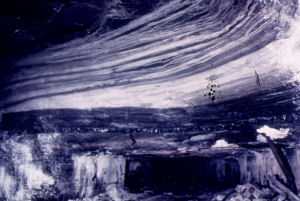Mining Topic: Geologic Characterization
What is the health and safety problem?
The U.S. underground mine worker faces a continuing hazard from roof falls and other ground control related hazards. Many injuries and fatalities are related to mine roof that is weakened as a result of geologic factors. The roof may consist of rock that is inherently low in strength such as drawrock, thinly bedded rock, or mudstone. Further, the roof may be weakened or damaged by discontinuities such as clay veins, slickensides, joints, faults, and paleochannels.
What is the extent of the problem?
Research relating to a wide range of geologic factors has contributed to the decline in the number of injuries and fatal accidents resulting from roof falls. However, according to Mine Safety and Health Administration (MSHA) statistics (1999-2008), falls of ground were responsible for the largest portion (26%) of fatal incidents in the coal mining industry and about 40% of fatal incidents in underground coal mining.
How is the NIOSH Mining Program addressing this problem?

View of underground rock strata
The NIOSH Mining Program has developed, and is continuing to improve, methods for characterizing ground and its probable response to mining so that potential hazards can be identified and prevented.
What are the significant findings?
A number of tools – in particular classification and test methods – have been and continue to be developed. These include Coal Mine Roof Rating (CMRR) software, ground hazard mapping, ground condition mapping, diagnosis of moisture sensitivity, and gas content testing.
What are the next steps?
Further development of classification and test methods will continue in order to improve the ability of mine workers to anticipate hazards well before they are exposed.
See Also
- Application of the Coal Mine Roof Rating (CMRR) to Extended Cuts
- An Approach to Identifying Geological Properties from Roof Bolter Drilling Parameters
- CMRR - Coal Mine Roof Rating - 2.1.03
- Current trends in Reducing Ground Fall Accidents in US Coal Mines
- Current Trends in Reducing Ground Fall Accidents in US Coal Mines
- Diagnosing and Controlling Moisture-Sensitive Roof in Coal Mines
- Dynamic Failure in Deep Coal: Recent Trends and a Path Forward
- Geologic Hazards and Roof Stability in Coal Mines
- Ground Control Safety for Deep Vein Mines
- International Experience with Longwall Mining into Pre-Driven Rooms
- A Measurement Method for Determining Absorption Coefficients for Underground Mines
- Optimizing Secondary Roof Support with the NIOSH Support Technology Optimization Program (STOP)
- Proceedings of the International Workshop on Rock Mass Classification in Underground Mining
- Proceedings: New Technology for Ground Control in Multiple-seam Mining
- Roof and Rib Hazard Assessment for Underground Stone Mines
- Shale Failure Mechanics and Intervention Measures in Underground Coal Mines: Results from 50 Years of Ground Control Safety Research
- Stability Mapping to Examine Ground Failure Risk: A Field Study at a Limestone Mine
- Technology News 478 - Apparatus for Measuring the Gas Content of Coal or Rock Core Samples
- Technology News 526 - Proceedings of the International Workshop on Rock Mass Classification in Underground Mining
- Using the Coal Mine Roof Rating (CMRR) to Assess Roof Stability in U.S. Coal Mines
- Page last reviewed: 1/11/2017
- Page last updated: 11/3/2015
- Content source: National Institute for Occupational Safety and Health, Mining Program


 ShareCompartir
ShareCompartir